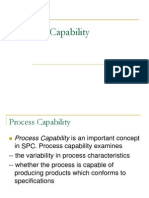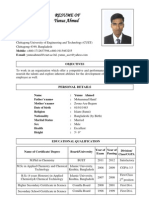Dr. Pham Huynh Tram Department of ISE Phtram@hcmiu - Edu.vn
Uploaded by
Ngọc Nhung VũDr. Pham Huynh Tram Department of ISE Phtram@hcmiu - Edu.vn
Uploaded by
Ngọc Nhung VũDr.
Pham Huynh Tram
Department of ISE
phtram@hcmiu.edu.vn
Review of basic probability & statistics
- Probability
- Types of data
- Describing data
Stabilizing and improving a process with control
charts
- Needs of control chart
- Structure of control chart
- Rules of identifying out-of-control point
- Possible mistakes un using control chart
Example: a bin contains 4000 screws; 2000 are good and
2000 are defective
What is the probability of drawing a defective screw?
- Classical probability
- Relative frequency probability
- Difference?
Sub-
group
No. of
defective
Fraction of
defective
Cummulative
no. of
defective
Cummulative
no. of screw
Cummulative
of fraction
1
2
3
4
5
6
7
Subgroup size :50
Pupose of collecting data?
Attribute data
- Classificaion of items into categories. Eg.: grade A, B, C
- Counts of the number of items in a given category or a
proportion in a given category
- Counts of the number of occurrences per unit. Eg.: no. of
defects per batch, no. of sales per month
Variables (measurment) data
- Measurement of a characteristic. Eg.: length of time to
resolve customer complaint, weights of boxes of detergent
- Computation of Numerical Value from two or more
measurements of variables data. Eg.: computation of a
rectangular containe, km per litre for each truck
For frequency distribution
Tabular displays
Graphical displays
- Histogram (variable data)
- Bar chart (attribute data)
- Ogive
- Run chart
The number of intervals
influences the pattern, shape, or spread
of your Histogram.
The width of the bar chart has no
significance
Run chart
Measures of central tendency:
Mean, median, mode, proportion
Measures of variability
Range, Standard diviation
Measures of shape
Skewness, kurtosis
Mode = 16
The mode is the most frequently occurring value. It is the value
with the highest frequency.
Given a data set:
9, 10, 6, 12, 16, 14, 19, 20, 14, 15, 22, 24, 13, 16, 17, 5, 17, 18,
19, 18, 16, 22
The mean of a set of observations is their
average - the sum of the observed values divided
by the number of observations.
Population Mean
Sample Mean
=
=
x
N
i
N
1
x
x
n
i
n
=
=
1
Range
Difference between maximum and minimum values
Variance
Mean
*
squared deviation from the mean
Standard Deviation
Square root of the variance
-
Definitions of population variance and sample variance differ slightly.
Population Variance Sample Variance
( )
N
N
x
x
N
x
N
i
N
i
N
i
2
1
1
2
1
2
2
|
.
|
\
|
=
=
=
o
2
o o =
( )
1
1
2
1
1
2
1
2
2
|
.
|
\
|
=
=
=
n
n
x
x
n
x x
s
n
i
n
i
n
i
2
s s=
Find the sample mean and sample variance for
the following series of data:
Value
21
12
34
22
17
18
43
28
56
34
12
Practice with Calculator !!
Skewness
Measure of asymmetry of a frequency distribution
Skewed to left
Symmetric or unskewed
Skewed to right
Kurtosis
Measure of flatness or peakedness of a frequency
distribution
Platykurtic (relatively flat)
Mesokurtic (normal)
Leptokurtic (relatively peaked)
Skewed to left
6 0 0 5 0 0 4 0 0 3 0 0 2 0 0 1 0 0
3 0
2 0
1 0
0
x
F
r
e
q
u
e
n
c
y
Mean < median < mode
Mean = median = mode
6 0 0 5 0 0 4 0 0 3 0 0 2 0 0 1 0 0
x
3 0
2 0
1 0
0
F
r
e
q
u
e
n
c
y
Symmetric
Mode < median < mean
6 0 0 5 0 0 4 0 0 3 0 0 2 0 0 1 0 0
x
3 0
2 0
1 0
0
F
r
e
q
u
e
n
c
y
Skewed to right
3 . 7 2 . 9 2 . 1 1 . 3 0 . 5 - 0 . 3 - 1 . 1 - 1 . 9 - 2 . 7 - 3 . 5
7 0 0
6 0 0
5 0 0
4 0 0
3 0 0
2 0 0
1 0 0
0
X
F
r
e
q
u
e
n
c
y
Platykurtic - flat distribution
4 3 2 1 0 - 1 - 2 - 3 - 4
5 0 0
4 0 0
3 0 0
2 0 0
1 0 0
0
X
F
r
e
q
u
e
n
c
y
Mesokurtic - not too flat and not too peaked
Leptokurtic - peaked distribution
1 0 0 - 1 0
2 0 0 0
1 0 0 0
0
Y
F
r
e
q
u
e
n
c
y
Normal distribution
Calculate probability
Skewed distribution
Unknown distribution
K = 1
K=2
K=3
6826 . 0 ) 1 1 ( = + < < o o X P
9544 . 0 ) 2 2 ( = + < < o o X P
9973 . 0 ) 3 3 ( = + < < o o X P
1
1
2
1
1
4
3
4
75%
1
1
3
1
1
9
8
9
89%
1
1
4
1
1
16
15
16
94%
2
2
2
= = =
= = =
= = =
At least of the elements of any distribution
lie within k standard deviations of the mean
|
.
|
\
|
2
1
1
k
At
least
Lie
within
Standard
deviations
of the mean
2
3
4
Control charts are constructed by drawing samples and
taking measurements of a process characteristics. Each set
of measurements is called a subgroup
Control charts help to
- identify and differentiate between common causes and
special causes of variation
- determine a processs capability
Process is stable if it only exhibits common cause variation
When a process is stable, continuous improvement helps to
bring the centerline of the process closer to a desired level
(nominal) by reducing the magnitude of common cause
variations
-Centerline: drawn at the average value of all the plotted data.
-Control Limits (UCL, LCL): set at a distance of 3 sigma above and 3
sigma below the centerline. They indicate variation from the centerline
* Difference between control limits and specification limits?
27
29
30
31
32
Rule 5: 8 or more successive values continually increase
or decrease
Rule 6: unusual small number of runs above and below
center line are present ( a sawtooth pattern)
Rule 7: 13 consecutive points fall in zone C
Over adjustment
Process should be adjusted not on the basis of time-to-
time observations, but on the basis of information
provided by a statistical control chart
Funnel experiment
Under adjustment
Lack of attention when the process is out of control and
no effort is made to provide neccesary regulation
*Also, becareful on false out-of control signal
Defect prevention: atribute chart
P chart, mp chart, c chart, u chart
Continuous improvement: variable control chart
X bar chart, R chart, MR chart, s chart
You might also like
- 20210705-104838-22-2-Testo - 3036T-X01 - F21000133 - RASOVA WINE PDFNo ratings yet20210705-104838-22-2-Testo - 3036T-X01 - F21000133 - RASOVA WINE PDF272 pages
- Statistical Quality Control: Simple Applications of Statistics in TQMNo ratings yetStatistical Quality Control: Simple Applications of Statistics in TQM57 pages
- Statistical Process Control (Control Chart)No ratings yetStatistical Process Control (Control Chart)32 pages
- X-Bar and S Charts: NCSS Statistical Software100% (1)X-Bar and S Charts: NCSS Statistical Software26 pages
- Unit Iii - Statistical Process Control: TQM Tools (Seven Tools of Quality) 1. Pareto Diagram 2. Flow DiagramNo ratings yetUnit Iii - Statistical Process Control: TQM Tools (Seven Tools of Quality) 1. Pareto Diagram 2. Flow Diagram11 pages
- Statistical Inference: Prepared By: Antonio E. Chan, M.DNo ratings yetStatistical Inference: Prepared By: Antonio E. Chan, M.D227 pages
- Error and Uncertainty: General Statistical PrinciplesNo ratings yetError and Uncertainty: General Statistical Principles8 pages
- Have You Ever : Shot A Rifle? Played Darts? Played Basketball?No ratings yetHave You Ever : Shot A Rifle? Played Darts? Played Basketball?39 pages
- 7 QC Tools: Check-Sheet Cause and Effect Pareto Histogram Control Chart Scatter Plot StratificationNo ratings yet7 QC Tools: Check-Sheet Cause and Effect Pareto Histogram Control Chart Scatter Plot Stratification55 pages
- Introduction To SPC (Statistical Process Control)No ratings yetIntroduction To SPC (Statistical Process Control)80 pages
- Lecture-2 Descriptive Statistics-Box Plot Descriptive MeasuresNo ratings yetLecture-2 Descriptive Statistics-Box Plot Descriptive Measures47 pages
- A Concise Presentation: Mr. Deepak SarangiNo ratings yetA Concise Presentation: Mr. Deepak Sarangi20 pages
- 02-Descriptive Statistics of Numerical Data - 52No ratings yet02-Descriptive Statistics of Numerical Data - 5261 pages
- Topic 2 Frequency Distribution and Data Presentation, Measures of Central Tendency and DispersionNo ratings yetTopic 2 Frequency Distribution and Data Presentation, Measures of Central Tendency and Dispersion46 pages
- A Concise Presentation: Mr. Deepak SarangiNo ratings yetA Concise Presentation: Mr. Deepak Sarangi20 pages
- Statistical Measures 2024 (Part 2) - WordNo ratings yetStatistical Measures 2024 (Part 2) - Word8 pages
- 06-14-PP CHAPTER 06 Continuous ProbabilityNo ratings yet06-14-PP CHAPTER 06 Continuous Probability81 pages
- Canatuan ME Lab. 3 Exercise 1 Statistical Process ControlNo ratings yetCanatuan ME Lab. 3 Exercise 1 Statistical Process Control17 pages
- Determing Statistical Significance of Skewness 121104No ratings yetDeterming Statistical Significance of Skewness 1211042 pages
- Probability and Statistics in EngineeringNo ratings yetProbability and Statistics in Engineering24 pages
- De-Mystifying Math and Stats for Machine Learning: Mastering the Fundamentals of Mathematics and Statistics for Machine LearningFrom EverandDe-Mystifying Math and Stats for Machine Learning: Mastering the Fundamentals of Mathematics and Statistics for Machine LearningNo ratings yet
- Recognition, Information Search, Evaluation of Alternatives, Purchase Decision, Post Purchase BehaviorNo ratings yetRecognition, Information Search, Evaluation of Alternatives, Purchase Decision, Post Purchase Behavior4 pages
- Application ID: 001790 Secret Key: Caef6bfaNo ratings yetApplication ID: 001790 Secret Key: Caef6bfa1 page
- Midterm Report: International UniversityNo ratings yetMidterm Report: International University16 pages
- Review of Robert Lanza & Bob Berman's Book Biocentrism How Life and Consciousness Are The Keys To Understanding The True Nature of The Universe100% (1)Review of Robert Lanza & Bob Berman's Book Biocentrism How Life and Consciousness Are The Keys To Understanding The True Nature of The Universe3 pages
- Key Changes AMS2750 Revision F July 2020No ratings yetKey Changes AMS2750 Revision F July 202037 pages
- Energy Methods in Structural Analysis: Version 2 CE IIT, KharagpurNo ratings yetEnergy Methods in Structural Analysis: Version 2 CE IIT, Kharagpur15 pages
- A Review of Anode Materials Development in Solid100% (1)A Review of Anode Materials Development in Solid35 pages
- GE Lighting Systems Price Book - Outdoor Designers Guide 4-77 - 9-77100% (1)GE Lighting Systems Price Book - Outdoor Designers Guide 4-77 - 9-7780 pages
- Chang K. Mathematical Structures of Quantum Mechanics 2011100% (1)Chang K. Mathematical Structures of Quantum Mechanics 2011208 pages
- Bending of High Strength Steel Docol Domex Hardox WeldoxlNo ratings yetBending of High Strength Steel Docol Domex Hardox Weldoxl8 pages
- Instalación Sensor Turbo Modificación 3-38-14en1No ratings yetInstalación Sensor Turbo Modificación 3-38-14en11 page
- Elliptic Systems of Phase Transition Type: Nicholas D. Alikakos Giorgio Fusco Panayotis SmyrnelisNo ratings yetElliptic Systems of Phase Transition Type: Nicholas D. Alikakos Giorgio Fusco Panayotis Smyrnelis349 pages
- Numerical Modeling of Vertical Drains With Smear ANo ratings yetNumerical Modeling of Vertical Drains With Smear A15 pages
- PRELIMS - RDT 104 (Technical Factors in Radiology)No ratings yetPRELIMS - RDT 104 (Technical Factors in Radiology)4 pages
- Fluid Planning - Field Applications & Brine MaintenanceNo ratings yetFluid Planning - Field Applications & Brine Maintenance38 pages
- EN9 Carbon Steel Bright Bar - EN9 Forging - EN9 Round - Saaj SteelNo ratings yetEN9 Carbon Steel Bright Bar - EN9 Forging - EN9 Round - Saaj Steel3 pages
- Limits Continuity and Differentia-Jeemain - GuruNo ratings yetLimits Continuity and Differentia-Jeemain - Guru17 pages
- 20210705-104838-22-2-Testo - 3036T-X01 - F21000133 - RASOVA WINE PDF20210705-104838-22-2-Testo - 3036T-X01 - F21000133 - RASOVA WINE PDF
- Statistical Quality Control: Simple Applications of Statistics in TQMStatistical Quality Control: Simple Applications of Statistics in TQM
- Unit Iii - Statistical Process Control: TQM Tools (Seven Tools of Quality) 1. Pareto Diagram 2. Flow DiagramUnit Iii - Statistical Process Control: TQM Tools (Seven Tools of Quality) 1. Pareto Diagram 2. Flow Diagram
- Statistical Inference: Prepared By: Antonio E. Chan, M.DStatistical Inference: Prepared By: Antonio E. Chan, M.D
- Error and Uncertainty: General Statistical PrinciplesError and Uncertainty: General Statistical Principles
- Have You Ever : Shot A Rifle? Played Darts? Played Basketball?Have You Ever : Shot A Rifle? Played Darts? Played Basketball?
- 7 QC Tools: Check-Sheet Cause and Effect Pareto Histogram Control Chart Scatter Plot Stratification7 QC Tools: Check-Sheet Cause and Effect Pareto Histogram Control Chart Scatter Plot Stratification
- Lecture-2 Descriptive Statistics-Box Plot Descriptive MeasuresLecture-2 Descriptive Statistics-Box Plot Descriptive Measures
- Topic 2 Frequency Distribution and Data Presentation, Measures of Central Tendency and DispersionTopic 2 Frequency Distribution and Data Presentation, Measures of Central Tendency and Dispersion
- Canatuan ME Lab. 3 Exercise 1 Statistical Process ControlCanatuan ME Lab. 3 Exercise 1 Statistical Process Control
- Determing Statistical Significance of Skewness 121104Determing Statistical Significance of Skewness 121104
- De-Mystifying Math and Stats for Machine Learning: Mastering the Fundamentals of Mathematics and Statistics for Machine LearningFrom EverandDe-Mystifying Math and Stats for Machine Learning: Mastering the Fundamentals of Mathematics and Statistics for Machine Learning
- Recognition, Information Search, Evaluation of Alternatives, Purchase Decision, Post Purchase BehaviorRecognition, Information Search, Evaluation of Alternatives, Purchase Decision, Post Purchase Behavior
- Review of Robert Lanza & Bob Berman's Book Biocentrism How Life and Consciousness Are The Keys To Understanding The True Nature of The UniverseReview of Robert Lanza & Bob Berman's Book Biocentrism How Life and Consciousness Are The Keys To Understanding The True Nature of The Universe
- Energy Methods in Structural Analysis: Version 2 CE IIT, KharagpurEnergy Methods in Structural Analysis: Version 2 CE IIT, Kharagpur
- GE Lighting Systems Price Book - Outdoor Designers Guide 4-77 - 9-77GE Lighting Systems Price Book - Outdoor Designers Guide 4-77 - 9-77
- Chang K. Mathematical Structures of Quantum Mechanics 2011Chang K. Mathematical Structures of Quantum Mechanics 2011
- Bending of High Strength Steel Docol Domex Hardox WeldoxlBending of High Strength Steel Docol Domex Hardox Weldoxl
- Elliptic Systems of Phase Transition Type: Nicholas D. Alikakos Giorgio Fusco Panayotis SmyrnelisElliptic Systems of Phase Transition Type: Nicholas D. Alikakos Giorgio Fusco Panayotis Smyrnelis
- Numerical Modeling of Vertical Drains With Smear ANumerical Modeling of Vertical Drains With Smear A
- PRELIMS - RDT 104 (Technical Factors in Radiology)PRELIMS - RDT 104 (Technical Factors in Radiology)
- Fluid Planning - Field Applications & Brine MaintenanceFluid Planning - Field Applications & Brine Maintenance
- EN9 Carbon Steel Bright Bar - EN9 Forging - EN9 Round - Saaj SteelEN9 Carbon Steel Bright Bar - EN9 Forging - EN9 Round - Saaj Steel






































































































